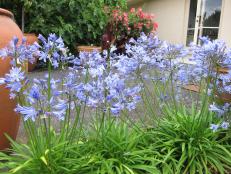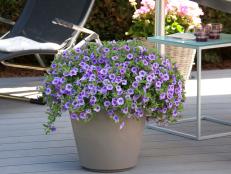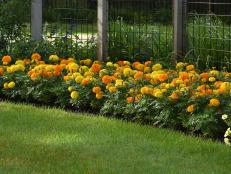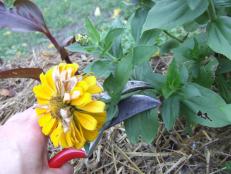Flower Show Secrets: Peek Behind the Scenes
Find out the top secret tricks that experts use to make their show gardens shine.


What’s up with – and behind – garden and flower shows?
I am an avid show attendee, sometimes a behind-scenes judge but always eager to be exposed to different concepts, new ideas and twists on old ones. Always looking for interesting combinations of plants both standard and never-before seen, and pleased to rub shoulders in a slow-moving trudge of garden-variety garden gawkers who are not afraid to express their views, both favorable and otherwise.
But these experiences come at a huge cost to those who design, build, plant, and show off their work, all for just a few days of actual viewing. The exotic displays are installed and completely removed within about a week and a half.
In addition to hosting dozens of educational exhibits, highlighting community projects, and vending an endless assortment of garden accoutrements, garden shows are ideal for showcasing styles, fashions, and horticultural delights. They are tapestries of plants and construction materials blended seamlessly to convey anything from bold extravagance to seemingly simple, tranquil displays of naturalism - all with a learning aspect.
Just as a home garden can take years to develop, it takes many months of tedious planning for one-shot show gardens to be pulled together. But at as show, everything has to be done to perfection, for a single week of viewing. And it takes time and skillful planning; spring flowering bulbs, for example, are started the summer before, with dexterous horticultural abilities employed to bring them into flower two months before they normally would in a regular garden. Topiary shrubs are carefully groomed, rocks “interviewed” in rural quarries for size, shape and color.
It’s all about capturing the beauty and intricacies of a real garden; even sculptures, which are often the most photographed first impressions, are selected to be perfect in appropriate style and scale for the specific garden. Some designers deliberately design in imperfections, from carefully-carelessly laid tools or a well-placed pile of horse manure in a cottage garden, to a single dandelion plant in an otherwise immaculate lawn.
Installing a live show garden has to be done to perfection from scratch, in just a few days. Though participants are brimming with ideas and supercharged with excitement, before it’s all over, most find themselves, at least once, feeling sick from gut-wrenching nerves.
Plans Into Reality – The Build-Up
For some 35 years, the quiet but fun-loving Michael Petrie, owner of Handmade Gardens, a landscape design, consulting and installation firm in the Philadelphia area, has designed top award-winning gardens for the Philadelphia Flower Show - the oldest, largest indoor flower show in the world.
Though he has earned many coveted honors, including being awarded ten First Place trophies, he sees the show as an opportunity to create a display that shows off his design and horticultural skills while throwing out creative ideas that can be translated into smaller-scale real home gardens.
Petrie jumps through some pretty predictable hoops as he prepares for his shows, as his beautiful and practical creations go from a “light bulb” concept to finished installations. Knowing that, after five days of being examined up close by critical judges and tens of thousands of gardeners, his precious work will be completely removed, down to the bare floor, as if it never existed.
Getting Started
Michael starts planning nearly a year ahead of time, as soon as he finds out what the show’s central theme will be, taking into account the restrictions and requirements of the venue. And he will have to balance how well his efforts will inspire show visitors, with what he knows his design and horticultural peers, the judges, will be looking for.
He checks the layout and square footage of where his garden will be built, comes up with a rough concept for the garden. “Once I get my main concept,” he explains, “I'll develop a perspective view of the exhibit keeping in mind there's usually one good ‘money shot’ where you want people to stand to see your idea.” As he toils over small thumbnail sketches he mentally walks around the non-existent garden from all angles, including thinking about how it may interact with what another designer may set up right next to his own.
Takeaway Lesson: When you are in your own garden, look up to see beyond it, do you take into account hiding bad views as well as framing and “borrowing” good views?
Then comes the small-scale model, to make sure it will all come together practically and fit into the allotted space, and he starts thinking about choosing materials he will need to construct realistic, life-size, workable garden buildings, walls, fences, gates, arbors, seating, paved walks, ponds, working waterfalls and streams, lighting, and garden art.
Timing is Everything
In addition to the tried-and-true backbone trees, shrubs, vines, perennial and annual flowers,bulbs, groundcovers, and lawn that all good gardens require, Petrie knows that it’s important to always have some new and interesting plants in the exhibit to keep the hard-core visitors and judges happy.
And from experience, he knows to choose plants that will be available, both locally and from afar, for a show held indoors in sometimes-snowy March. Usually this means contracting greenhouse growers to test their best horticultural skills, starting months ahead of time “forcing” plants unnaturally into foliage or flower, timed for perfection in a very narrow window.
The Philadelphia show allows four days for set-up. Petrie starts by laying out his floor plan, on the bare concrete of the showroom, using spray paint. He then starts moving in and assembling his partially-constructed “hard” projects, then the large potted trees and shrubs, and piles the sawdust he uses as “soil” in which he carefully sets the smaller plants and scouring the region for last-minute substitutions for plants that aren’t perfectly up to par.
The rest of the garden goes together “like any garden would,” as he says, “bit by bit.”
Overnight
After five days of intense pressure from tens of thousands of visitors, comes “the tear-down” –hauling stuff back out and dismantling constructed features. It takes just two days to get it back down to clean floor. The sawdust is saved for next year, and garden features and plants – which can take two months to rebound from being indoors for just one week - are reused in other gardens or donated to local organizations such as Habitat for Humanity or urban gardening groups. The rest goes into the dumpster.
Costs and Benefits
While small, local flowers shows can be put together on a shoestring budget, some of the largest can cost more than most people make in a lifetime. Estimates from England’s 2014 Chelsea Flower Show are that the gardens run from three hundred thousand to nearly two million dollars to install - for five days of viewing. Petrie estimates that a Philadelphia Flower Show garden costs from sixty to well over a hundred thousand dollars to construct, without taking into account the months of skilled planning or the countless unpaid hours for labor to install, staff, maintain, and then tear down the actual show. Or the volunteers who are a huge part of pulling off such as large event.
The payback for all this effort, from which everyone wants to emerge a winner, is complex. Petrie wonders “Who wouldn’t want to be part of the biggest indoor flower show in the world? It’s a great opportunity to display your talents beyond ordinary garden design work.” (This is a man who one year created a garden out of used tires, wine bottles, and other recycled trash, and won the 150-year show’s first and only perfect 100 score from every judge).
But beyond being a design and horticultural challenge and promotional event, is the thing that eats at every one of us in our own gardens: The response from others. “It’s the best, most interesting opportunity for me to have my work be judged critically,” Michael admits, “and then stand there for days to watch the reactions and listen to the responses of thousands of gardeners. “There is no better way to refine your design skills.”













































